West Kimberley
Water and Dust - Guess
What That Makes?
No, Not Mistake After Mistake,
It's The Bungle Bungle ...... After stocking
up with a few supplies we left Kununurra for our trek into the Bungle Bungle
(Purnululu National Park) which is 250 km south of Kununurra or 109 km
north of Halls Creek. A very straight highway took us to Turkey Creek
where we left the caravan and went into the Bungle Bungle. It is
definitely a 4 WD track of 53 kms to the Ranger Station which took us 2
1/2 hours to complete. The track is full of corrugations and a large
number of river and creek crossings. The majority of the crossings
were relatively easy except for two or three where the water level
was deeper, but did not cause us any problems. From the Great Northern
Highway turnoff into Bungle Bungle and back to the highway we had to go
through 82 water crossings. Takes us back to Cape York.
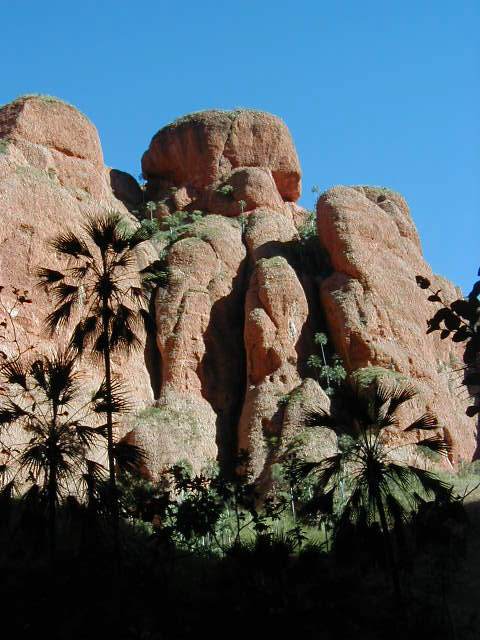 We
arrived at Kurrajong campsite which is one of two camp sites available
for camping just before dusk. With a beautiful clear day we set off to
walk the chasms and gorges. The Bungle Bungle Range is known
for its striking sandstone domes striped with orange and grey bands,
which have been carved out over the last 20 million years leaving spectacular
gorges and landscapes. The National Park is 209,000 hectares with
an adjoining 110,000 hectares as conservation reserve.
We
arrived at Kurrajong campsite which is one of two camp sites available
for camping just before dusk. With a beautiful clear day we set off to
walk the chasms and gorges. The Bungle Bungle Range is known
for its striking sandstone domes striped with orange and grey bands,
which have been carved out over the last 20 million years leaving spectacular
gorges and landscapes. The National Park is 209,000 hectares with
an adjoining 110,000 hectares as conservation reserve.
Echidna Chasm was a 2 km return walk over pebbles, rocks and a number
of larger boulders and as you walked in, it became narrower and narrower,
until you could touch each wall. As you looked up you were confronted
with 200 metres of sheer cliff face and at the top there was blue sky.
The photo to the left is the entrance to Echidna Chasm before it starts
to get narrow.
Another interesting walk was Frog Hole. This was a moderate walk
of 1.4 km to a small seasonal pool filled with little brown friendly frogs.
As we walked into the Froghole, there were a couple lying down gazing up
to the sky. It turned out they were from Ballarat and Liz knew Marg
from the Ballarat Indoor Tennis competition. It really is a small
world.
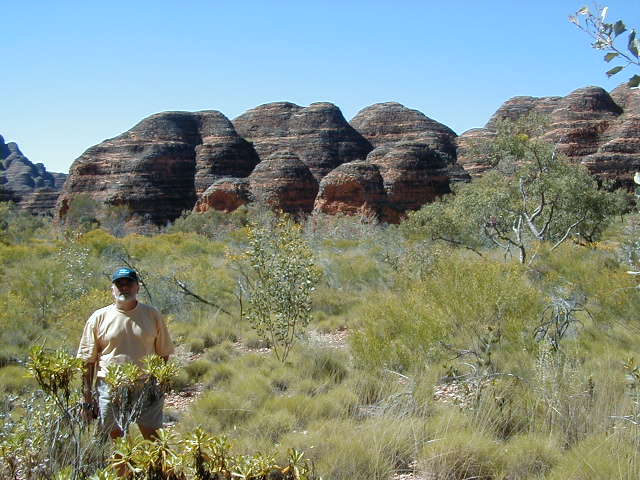 Cathedral
Gorge would have to be the highlight of the Bungle Bungle. It is
a fairly easy 3 km return walk which takes you passed some spectacular
scenery of the Bungle Bungle. This is where the beehive domes are
located. To be amongst these domes was truly amazing and then to
walk into this big amphitheater with soaring cliff faces reaching up to
the sky made the walk so memorable. This National Park should be
classified as one of the Seven Natural Wonders of the World.
Cathedral
Gorge would have to be the highlight of the Bungle Bungle. It is
a fairly easy 3 km return walk which takes you passed some spectacular
scenery of the Bungle Bungle. This is where the beehive domes are
located. To be amongst these domes was truly amazing and then to
walk into this big amphitheater with soaring cliff faces reaching up to
the sky made the walk so memorable. This National Park should be
classified as one of the Seven Natural Wonders of the World.
Our trek back to the highway was eventful. You must allow enough
time to return to the highway before sunset which is just after 5.00 pm,
so we set off around 2.30 pm. At the deepest river crossing,
we came across a young guy who had had to be towed out of the river and
was left high and dry ( we mean wet, very wet). His Suzuki was dead,
all his clothes and bedding were wet and the inside of the car still full
of water. Fortunately Rob and two other guys travelling behind us
managed to get the engine started and on his way. After spending
45 minutes assisting him, we were able to just reach the highway just as
it was getting dark.
After one overnight stop at Turkey Creek, we headed towards Halls Creek,
an interesting town, with the main street being quite clean and tidy.
We stopped here for morning tea before moving onto our next off road stop
at Mary River where we camped on the banks of the river. We then
moved onto Fitzroy Crossing, and stayed overnight at Fitzroy Crossing
River Lodge. We went into the Geike Gorge and walked the gorge. The
most interesting spot was the Crossing Hotel, the oldest pub in the Kimberley.
We drove into the area and were confronted with up to at least 30 locals
outside the pub. We decided to just say hello and wave and continue
on our way, returning to watch the local footy match at the town oval.
Many of the aboriginals playing in this match wore no shoes but could kick
the ball and mark better than most St. Kilda players.
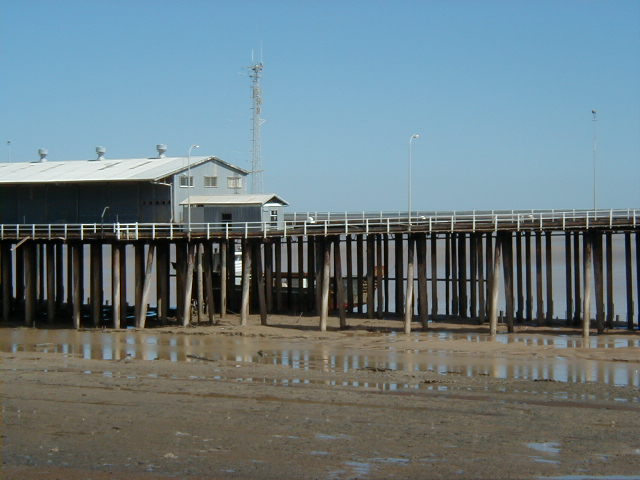 Wow,
The Tides Are Big .....
The next drive of 260 kms brought us to Derby situated on King Sound and
the northern most town in Western Australia. It is also the
western gateway to the Gibb River Road and Buccaneer Archipelago.
The main attraction here are the huge tides. There is a difference
of 11 metres between low tide and high tide while we were there.
We saw the beautiful sunset and on this particular night met two very interesting
aboriginals who were fishing for mudcrabs off the pier. By coincidence,
the man grew up in Ballarat and attended our children's primary and secondary
schools. He had returned to Arnhem Land to be with his people and
we were invited to visit them at any time and meet their people, so names
and addresses were exchanged.
Wow,
The Tides Are Big .....
The next drive of 260 kms brought us to Derby situated on King Sound and
the northern most town in Western Australia. It is also the
western gateway to the Gibb River Road and Buccaneer Archipelago.
The main attraction here are the huge tides. There is a difference
of 11 metres between low tide and high tide while we were there.
We saw the beautiful sunset and on this particular night met two very interesting
aboriginals who were fishing for mudcrabs off the pier. By coincidence,
the man grew up in Ballarat and attended our children's primary and secondary
schools. He had returned to Arnhem Land to be with his people and
we were invited to visit them at any time and meet their people, so names
and addresses were exchanged.
 The
Infamous Gibb River Road.... After stocking up with
food and storing the caravan we hit the Gibb River Road and headed for
Windjana Gorge. The camping ground here was quite good with flushing
toilets and cold showers. Liz tackled the cold showers but definitely
before sunset as it cooled down considerably once the sun disappeared for
the day. Rob used the "wimpy" shower (named by the ranger).
This was the solar shower hung from the nearest tree. This gorge
is 3.5 km long and opens up onto a wide sandy beach with towering coloured
ancient cliffs. Here we were able to see a number of fresh water
crocodiles just lazing themselves on the sand and on the rocks in the pools.
There are supposed to be over 70 of them in the gorge and it is amazing
how close to them you can actually get before they scuttle of into the
water. The photo is taken from the camp ground with the Devonian
Reef of the Napier Range in the background.
The
Infamous Gibb River Road.... After stocking up with
food and storing the caravan we hit the Gibb River Road and headed for
Windjana Gorge. The camping ground here was quite good with flushing
toilets and cold showers. Liz tackled the cold showers but definitely
before sunset as it cooled down considerably once the sun disappeared for
the day. Rob used the "wimpy" shower (named by the ranger).
This was the solar shower hung from the nearest tree. This gorge
is 3.5 km long and opens up onto a wide sandy beach with towering coloured
ancient cliffs. Here we were able to see a number of fresh water
crocodiles just lazing themselves on the sand and on the rocks in the pools.
There are supposed to be over 70 of them in the gorge and it is amazing
how close to them you can actually get before they scuttle of into the
water. The photo is taken from the camp ground with the Devonian
Reef of the Napier Range in the background.
From Windjana we took a day trip to Tunnel Creek approximately 40 kms
down the road. This was a fascinating place. First of all you
had to clamber over some quite large boulders to reach the entrance to
the tunnel which runs for 750 metres before reaching daylight at the end.
You need a very good torch and sandshoes or sandals, and bathers as the
water in parts of the tunnel reaches your hips depending on your height.
We commenced the walk and waded through the darkness treading carefully
as we went and found that there was no one else in the tunnel. This
gave Liz the feeling of being in an Indiana Jones movie minus the snakes.
Half way along it opens up and the light shines down, then again you are
plunged into darkness until you reach the end. The way back seemed
much easier as there were more people with torches lighting the way.
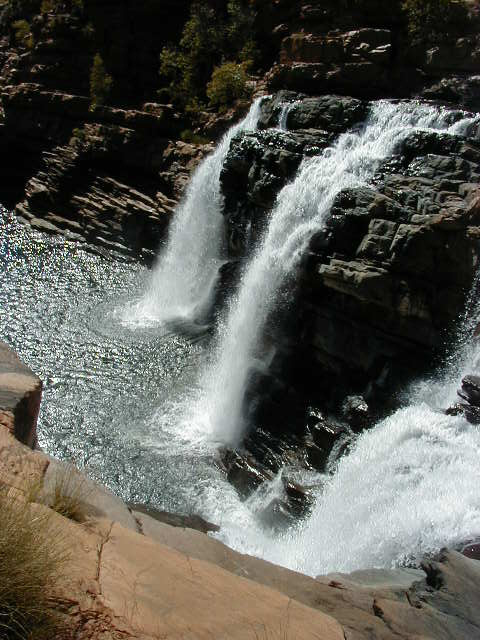 This
Region is Just Gorge-Us...... After two nights
at Windjana Gorge we moved onto Dog Chain Creek, a very small off road
camp site which we shared with Shane and Julie from Port Lincoln and Graham
and his beautiful german shepherd dog called Delta, who we got to know
very well over the next few days. Before the day was through we drove
the 7 km into Lennard River Gorge. The road in is definitely a 4
WD track with the last 1 1/2 kms very rough indeed, but it was well worth
it. This gorge is absolutely spectacular. From the top you
look down into the gorge with a 100 metre drop to the waterfalls pool and
the river that flows through the narrow gorge. We managed to climb
down to a sandy beach and we could then rock hop across to be at the
top of the waterfalls. There was so much water flowing that it made
a great sight. We had a beautiful swim in the very bracing but refreshing
water and watched the water monitors basking on the rocks in the sun.
This
Region is Just Gorge-Us...... After two nights
at Windjana Gorge we moved onto Dog Chain Creek, a very small off road
camp site which we shared with Shane and Julie from Port Lincoln and Graham
and his beautiful german shepherd dog called Delta, who we got to know
very well over the next few days. Before the day was through we drove
the 7 km into Lennard River Gorge. The road in is definitely a 4
WD track with the last 1 1/2 kms very rough indeed, but it was well worth
it. This gorge is absolutely spectacular. From the top you
look down into the gorge with a 100 metre drop to the waterfalls pool and
the river that flows through the narrow gorge. We managed to climb
down to a sandy beach and we could then rock hop across to be at the
top of the waterfalls. There was so much water flowing that it made
a great sight. We had a beautiful swim in the very bracing but refreshing
water and watched the water monitors basking on the rocks in the sun.
It was then onto Adcock Gorge, a smaller gorge with a waterfall and
very popular with the tourists. This was mainly due to the track
in being so much easier. Galvans Gorge was another smaller gorge
- less tourists and therefore a beautiful place to have a peaceful swim
up to the waterfall where you could sit under the actual waterfall and
let the water, which had been warmed by the rocks, splash over you.
Unfortunately Bell Gorge was not open. The big wet season has
caused a delay in the opening of roads in the Kimberley and at the moment
there is talk of Bell Gorge not being opened for the season. This
was a pity as we were looking forward to spending a few days there.
It was then onto Mount Barnett Roadhouse and into Manning Gorge.
Here we set up camp for a few days in the camp ground. There are
only pit toilets and no showers so it was either swim in the gorge or indulge
yourself in a solar shower strung up in a tree. 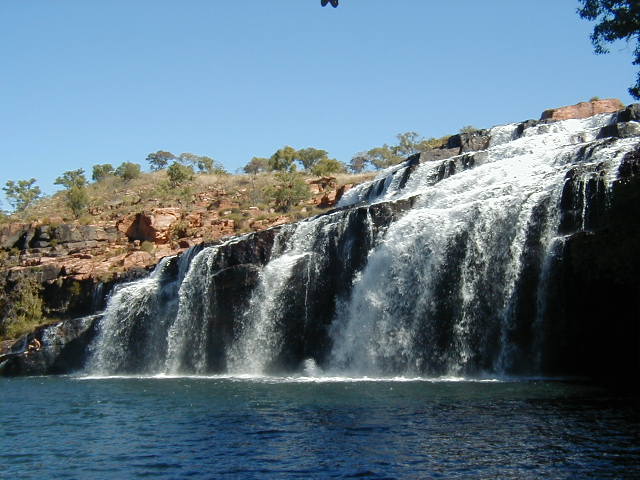 Manning Gorge is another fantastic gorge approximately a 1 1/2 hour walk
from the camp ground. To reach it means either swimming across the
Lower Manning Gorge which is about 50 metres (nothing compared to the 500
metre swim at Twin Falls in Kakadu) or wading through water and rock hopping
further downstream. Our party (with Delta in tow) opted to wade through
as the guys had camera equipment. The walk was defined by empty cans
hanging off trees and rock cairns and a few arrows. We eventually
reach the Upper Manning Gorge and were confronted by this very wide waterfall
that fell into a huge swimming pool and then flowed down into the river.
Again, we swam to the rocky edge of the waterfall and soaked up the atmosphere.
We stayed here for lunch and returned later in the afternoon. Delta
led the way home and she was amazing. She knew her way back without
one mistake being made. This made the trip home much faster.
Manning Gorge is another fantastic gorge approximately a 1 1/2 hour walk
from the camp ground. To reach it means either swimming across the
Lower Manning Gorge which is about 50 metres (nothing compared to the 500
metre swim at Twin Falls in Kakadu) or wading through water and rock hopping
further downstream. Our party (with Delta in tow) opted to wade through
as the guys had camera equipment. The walk was defined by empty cans
hanging off trees and rock cairns and a few arrows. We eventually
reach the Upper Manning Gorge and were confronted by this very wide waterfall
that fell into a huge swimming pool and then flowed down into the river.
Again, we swam to the rocky edge of the waterfall and soaked up the atmosphere.
We stayed here for lunch and returned later in the afternoon. Delta
led the way home and she was amazing. She knew her way back without
one mistake being made. This made the trip home much faster.
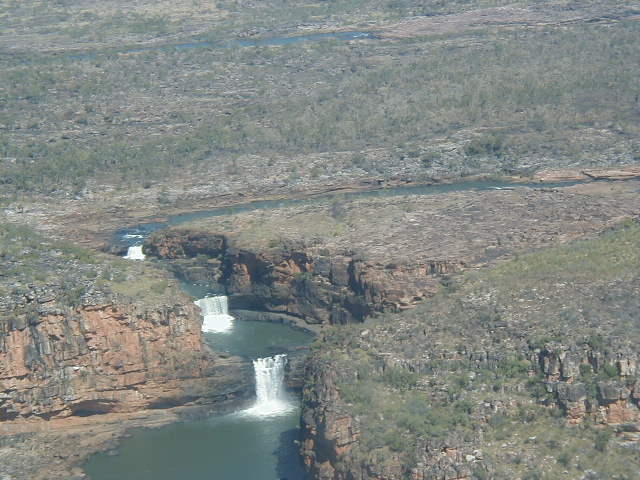 The next day
saw our new found friends go their different ways. We headed for
Mt. Elizabeth Station where we hoped to do some horse riding and cattle
mustering, but again, due to the wet season, everything has been set back
and these options were not available. Instead, we took a 130 minute
scenic flight over the Mitchell Falls, Mitchell Plateau, Kings Cascade,
the Prince Regent River area, and the Prince Frederick Harbour. It
was good to see some of this area, especially the Mitchell Falls (photo
to left) as we had intended to travel the Kalumburu Road, but again, the
road is closed and it will be quite some time before it is opened again.
There is a large volume of water flowing in the river system throughout
this area.
The next day
saw our new found friends go their different ways. We headed for
Mt. Elizabeth Station where we hoped to do some horse riding and cattle
mustering, but again, due to the wet season, everything has been set back
and these options were not available. Instead, we took a 130 minute
scenic flight over the Mitchell Falls, Mitchell Plateau, Kings Cascade,
the Prince Regent River area, and the Prince Frederick Harbour. It
was good to see some of this area, especially the Mitchell Falls (photo
to left) as we had intended to travel the Kalumburu Road, but again, the
road is closed and it will be quite some time before it is opened again.
There is a large volume of water flowing in the river system throughout
this area.
Our last stop before heading back to Derby had to be Lennard River Gorge,
just to see it one more time. So we again tackled the road in and
spent the morning there. It was then one more camp stop and then back to
Derby. We managed to catch up with our Ballarat friends, Judy and
Gary and as they had travelled to Broome and Cape Leveque, we were able
to exchange stories and information. Judy and Gary were heading off
on the Gibb River Road back to Kununurra.
The
highlight of this section:
This is a tough decision as the
last three weeks have all been a highlight of our trip so far but if we
have to make a decision then it is the Bungle Bungle. A real
4 WD adventure to get into the National Park and fantastic natural wonders
that have to be seen to be believed.
Until our next update.
Regards, Rob
& Liz
Page now complete - No further updates to this page.
 We
arrived at Kurrajong campsite which is one of two camp sites available
for camping just before dusk. With a beautiful clear day we set off to
walk the chasms and gorges. The Bungle Bungle Range is known
for its striking sandstone domes striped with orange and grey bands,
which have been carved out over the last 20 million years leaving spectacular
gorges and landscapes. The National Park is 209,000 hectares with
an adjoining 110,000 hectares as conservation reserve.
We
arrived at Kurrajong campsite which is one of two camp sites available
for camping just before dusk. With a beautiful clear day we set off to
walk the chasms and gorges. The Bungle Bungle Range is known
for its striking sandstone domes striped with orange and grey bands,
which have been carved out over the last 20 million years leaving spectacular
gorges and landscapes. The National Park is 209,000 hectares with
an adjoining 110,000 hectares as conservation reserve.
 Cathedral
Gorge would have to be the highlight of the Bungle Bungle. It is
a fairly easy 3 km return walk which takes you passed some spectacular
scenery of the Bungle Bungle. This is where the beehive domes are
located. To be amongst these domes was truly amazing and then to
walk into this big amphitheater with soaring cliff faces reaching up to
the sky made the walk so memorable. This National Park should be
classified as one of the Seven Natural Wonders of the World.
Cathedral
Gorge would have to be the highlight of the Bungle Bungle. It is
a fairly easy 3 km return walk which takes you passed some spectacular
scenery of the Bungle Bungle. This is where the beehive domes are
located. To be amongst these domes was truly amazing and then to
walk into this big amphitheater with soaring cliff faces reaching up to
the sky made the walk so memorable. This National Park should be
classified as one of the Seven Natural Wonders of the World.
 Wow,
The Tides Are Big .....
The next drive of 260 kms brought us to Derby situated on King Sound and
the northern most town in Western Australia. It is also the
western gateway to the Gibb River Road and Buccaneer Archipelago.
The main attraction here are the huge tides. There is a difference
of 11 metres between low tide and high tide while we were there.
We saw the beautiful sunset and on this particular night met two very interesting
aboriginals who were fishing for mudcrabs off the pier. By coincidence,
the man grew up in Ballarat and attended our children's primary and secondary
schools. He had returned to Arnhem Land to be with his people and
we were invited to visit them at any time and meet their people, so names
and addresses were exchanged.
Wow,
The Tides Are Big .....
The next drive of 260 kms brought us to Derby situated on King Sound and
the northern most town in Western Australia. It is also the
western gateway to the Gibb River Road and Buccaneer Archipelago.
The main attraction here are the huge tides. There is a difference
of 11 metres between low tide and high tide while we were there.
We saw the beautiful sunset and on this particular night met two very interesting
aboriginals who were fishing for mudcrabs off the pier. By coincidence,
the man grew up in Ballarat and attended our children's primary and secondary
schools. He had returned to Arnhem Land to be with his people and
we were invited to visit them at any time and meet their people, so names
and addresses were exchanged.
 The
Infamous Gibb River Road.... After stocking up with
food and storing the caravan we hit the Gibb River Road and headed for
Windjana Gorge. The camping ground here was quite good with flushing
toilets and cold showers. Liz tackled the cold showers but definitely
before sunset as it cooled down considerably once the sun disappeared for
the day. Rob used the "wimpy" shower (named by the ranger).
This was the solar shower hung from the nearest tree. This gorge
is 3.5 km long and opens up onto a wide sandy beach with towering coloured
ancient cliffs. Here we were able to see a number of fresh water
crocodiles just lazing themselves on the sand and on the rocks in the pools.
There are supposed to be over 70 of them in the gorge and it is amazing
how close to them you can actually get before they scuttle of into the
water. The photo is taken from the camp ground with the Devonian
Reef of the Napier Range in the background.
The
Infamous Gibb River Road.... After stocking up with
food and storing the caravan we hit the Gibb River Road and headed for
Windjana Gorge. The camping ground here was quite good with flushing
toilets and cold showers. Liz tackled the cold showers but definitely
before sunset as it cooled down considerably once the sun disappeared for
the day. Rob used the "wimpy" shower (named by the ranger).
This was the solar shower hung from the nearest tree. This gorge
is 3.5 km long and opens up onto a wide sandy beach with towering coloured
ancient cliffs. Here we were able to see a number of fresh water
crocodiles just lazing themselves on the sand and on the rocks in the pools.
There are supposed to be over 70 of them in the gorge and it is amazing
how close to them you can actually get before they scuttle of into the
water. The photo is taken from the camp ground with the Devonian
Reef of the Napier Range in the background.
 This
Region is Just Gorge-Us...... After two nights
at Windjana Gorge we moved onto Dog Chain Creek, a very small off road
camp site which we shared with Shane and Julie from Port Lincoln and Graham
and his beautiful german shepherd dog called Delta, who we got to know
very well over the next few days. Before the day was through we drove
the 7 km into Lennard River Gorge. The road in is definitely a 4
WD track with the last 1 1/2 kms very rough indeed, but it was well worth
it. This gorge is absolutely spectacular. From the top you
look down into the gorge with a 100 metre drop to the waterfalls pool and
the river that flows through the narrow gorge. We managed to climb
down to a sandy beach and we could then rock hop across to be at the
top of the waterfalls. There was so much water flowing that it made
a great sight. We had a beautiful swim in the very bracing but refreshing
water and watched the water monitors basking on the rocks in the sun.
This
Region is Just Gorge-Us...... After two nights
at Windjana Gorge we moved onto Dog Chain Creek, a very small off road
camp site which we shared with Shane and Julie from Port Lincoln and Graham
and his beautiful german shepherd dog called Delta, who we got to know
very well over the next few days. Before the day was through we drove
the 7 km into Lennard River Gorge. The road in is definitely a 4
WD track with the last 1 1/2 kms very rough indeed, but it was well worth
it. This gorge is absolutely spectacular. From the top you
look down into the gorge with a 100 metre drop to the waterfalls pool and
the river that flows through the narrow gorge. We managed to climb
down to a sandy beach and we could then rock hop across to be at the
top of the waterfalls. There was so much water flowing that it made
a great sight. We had a beautiful swim in the very bracing but refreshing
water and watched the water monitors basking on the rocks in the sun.
 Manning Gorge is another fantastic gorge approximately a 1 1/2 hour walk
from the camp ground. To reach it means either swimming across the
Lower Manning Gorge which is about 50 metres (nothing compared to the 500
metre swim at Twin Falls in Kakadu) or wading through water and rock hopping
further downstream. Our party (with Delta in tow) opted to wade through
as the guys had camera equipment. The walk was defined by empty cans
hanging off trees and rock cairns and a few arrows. We eventually
reach the Upper Manning Gorge and were confronted by this very wide waterfall
that fell into a huge swimming pool and then flowed down into the river.
Again, we swam to the rocky edge of the waterfall and soaked up the atmosphere.
We stayed here for lunch and returned later in the afternoon. Delta
led the way home and she was amazing. She knew her way back without
one mistake being made. This made the trip home much faster.
Manning Gorge is another fantastic gorge approximately a 1 1/2 hour walk
from the camp ground. To reach it means either swimming across the
Lower Manning Gorge which is about 50 metres (nothing compared to the 500
metre swim at Twin Falls in Kakadu) or wading through water and rock hopping
further downstream. Our party (with Delta in tow) opted to wade through
as the guys had camera equipment. The walk was defined by empty cans
hanging off trees and rock cairns and a few arrows. We eventually
reach the Upper Manning Gorge and were confronted by this very wide waterfall
that fell into a huge swimming pool and then flowed down into the river.
Again, we swam to the rocky edge of the waterfall and soaked up the atmosphere.
We stayed here for lunch and returned later in the afternoon. Delta
led the way home and she was amazing. She knew her way back without
one mistake being made. This made the trip home much faster.
 The next day
saw our new found friends go their different ways. We headed for
Mt. Elizabeth Station where we hoped to do some horse riding and cattle
mustering, but again, due to the wet season, everything has been set back
and these options were not available. Instead, we took a 130 minute
scenic flight over the Mitchell Falls, Mitchell Plateau, Kings Cascade,
the Prince Regent River area, and the Prince Frederick Harbour. It
was good to see some of this area, especially the Mitchell Falls (photo
to left) as we had intended to travel the Kalumburu Road, but again, the
road is closed and it will be quite some time before it is opened again.
There is a large volume of water flowing in the river system throughout
this area.
The next day
saw our new found friends go their different ways. We headed for
Mt. Elizabeth Station where we hoped to do some horse riding and cattle
mustering, but again, due to the wet season, everything has been set back
and these options were not available. Instead, we took a 130 minute
scenic flight over the Mitchell Falls, Mitchell Plateau, Kings Cascade,
the Prince Regent River area, and the Prince Frederick Harbour. It
was good to see some of this area, especially the Mitchell Falls (photo
to left) as we had intended to travel the Kalumburu Road, but again, the
road is closed and it will be quite some time before it is opened again.
There is a large volume of water flowing in the river system throughout
this area.